Church in Leicester Castle, England
| St Mary de Castro, Leicester | |
|---|---|
 North facade from Castle View showing Norman chancel and Gothic north nave, north aisle and St Anne's Chapel North facade from Castle View showing Norman chancel and Gothic north nave, north aisle and St Anne's Chapel | |
| 52°37′56″N 1°08′25″W / 52.6323°N 1.1404°W / 52.6323; -1.1404 | |
| Location | Leicester Castle |
| Country | England |
| Denomination | Church of England |
| Previous denomination | Catholic Church |
| Churchmanship | Anglo-Catholic |
| History | |
| Dedication | St Mary de Castro "St Mary of the Castle" |
| Administration | |
| Province | Canterbury |
| Diocese | Leicester |
| Archdeaconry | Leicester |
| Parish | St Mary de Castro |
| Clergy | |
| Bishop(s) | Rt Revd Norman Banks SSC (AEO) |
| Listed Building – Grade I | |
| Designated | 1950 |
| Reference no. | 1074070 |
St Mary de Castro is an ancient, Grade I listed church in Leicester, England, located within the bailey of Leicester Castle. Today it acts as a Church of England parish church in the Diocese of Leicester. "St Mary de Castro" is Latin for "St Mary of the Castle"; a name chosen to differentiate from nearby "St Mary de Pratis": "St. Mary of the Meadows".
The building was closed in 2011 to the public after the spire was found to be unsafe but as of April 2015 is open again. The spire has been taken down, and funds are currently insufficient to replace it and repair the tower beneath.
It is believed to have been the first church in the UK to be viewable online using Google Street View, having been photographed in August 2012.
Architectural history

The foundation of the first church on the site dates to the year 918 and the reconquest of Danish occupied Leicester by Anglo Saxon forces under Ethelfleda, Lady of the Mercians, and Edward the Elder, both children of Alfred the Great. They were responsible for the reconstruction of the towns walls, the restoration of St Nicholas, and the first church on the site of Leicester Castle. It became a collegiate church by 1107 after Henry I of England granted the lands and castle to Robert de Beaumont, although the chronicler Henry Knighton implies that an Anglo-Saxon college of St Mary had already existed at the church before and that Robert merely refurbished it. Robert established it within the castle bailey as a college served by a Dean and 12 Canons in honour of the Virgin Mary and All Souls and as a chantry chapel for the souls of him, his family and the first three Norman kings. He endowed this and four other churches with £6 of his income and land in or near the city. However, in 1143 these endowments were all transferred by his son Robert le Bossu, 2nd Earl of Leicester, to his own new Augustinian foundation of Leicester Abbey. The collegiate church retained, or had restored to it a dean, six clerks and a chaplain, along with Robert de Beaumont's grant of 20 shillings for lamps. It also retained parish offerings and most of the tithes. The collegiate nature of the church lasted until the college was disbanded in 1548 under the Chantry Act of Edward VI.

The early-12th-century church had no aisles, and various parts of these walls survive. It underwent a major expansion in the 1160, with a north aisle, doorways to north and west, and an extension to the chancel. The two doorways provide striking external Norman zigzag decoration, but it is the sedilia and piscina in the Chancel extension that Pevsner describes as "the finest piece of Norman decoration in the county". Thirteenth-century alterations culminated in a major reworking of transepts and south aisle, to create an aisle wider than the nave, providing much more space for local parishioners. Also the huge east window of the south aisle, with ingenious tracery, was created around 1300. The tower was built inside the south aisle, apparently as an afterthought, rising to a quatrefoil frieze, four decorated pinnacles, and the needlelike spire rising from the battlements. The spire was completely rebuilt in 1783, but retained its crockets and three tiers of lucarnes. The interior was worked on by George Gilbert Scott throughout the 1860s.

Famous events
It is rumoured that here, around 1366, Geoffrey Chaucer married Philippa (de) Roet (a lady-in-waiting to Edward III's queen, Philippa of Hainault, and a sister of Katherine Swynford who later (c. 1396) became the third wife of Chaucer's friend and patron, John of Gaunt).
The infant king Henry VI was knighted in the church at Whitsuntide 1426 by his uncle, John of Lancaster, Duke of Bedford, the Regent of France (whilst the Parliament of Bats was being held at the Castle). Henry then proceeded to himself dub a further 44 knights on the same occasion, the first of whom was Richard Plantagenet, 3rd Duke of York.
William Bickerstaffe, a charitable local schoolmaster and antiquarian, was baptised, buried and held a seven-year curacy at the church.
Spire
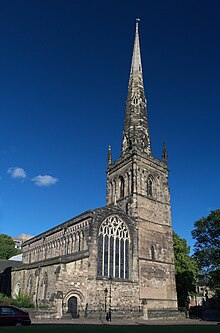
The church was closed when the spire was found to be unsafe. The 14th-century octagonal spire, having been rebuilt in 1783, had developed six-metre-long cracks in four of its faces in September 2013. After inspections by structural engineers, it was deemed at risk of collapse. The severe condition of the spire meant it had to be demolished, at an estimated cost of £200,000, in 2014. Over £358,000 has been raised since 2011; however, there are currently insufficient funds to rebuild the spire and repair the tower.
Organ
The church contains a three manual pipe organ which was originally installed in 1860 by Forster and Andrews. It has been the subject of modifications and restorations in 1880 by Joshua Porritt, and R. J. Winn in 1960. A specification of the organ can be found on the National Pipe Organ Register.

Organists
- Henry Bramley Ellis organist 1878–1910
- Benjamin Burrows 1910–?
- William Snow, father of C. P. Snow 1930 – c. 1950
- John M. Bence 1962 - 2020
- Andrew Green 2020 -
Galleries
- Norman stonework
-
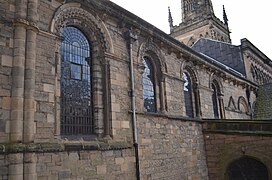 Norman chancel extern north facade (note grotesque corbels and arches)
Norman chancel extern north facade (note grotesque corbels and arches)
-
 Norman chancel extern south facade (note grotesque corbels and arches)
Norman chancel extern south facade (note grotesque corbels and arches)
-
 Chancel sedilia
Chancel sedilia
-
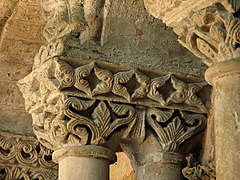 Close up of sedilia mouldings
Close up of sedilia mouldings
-
 West Door
West Door
-
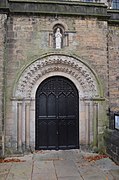 North Door
North Door
- Stained glass
-
 Chancel East Windows North Arch (Crucifixion)
Chancel East Windows North Arch (Crucifixion)
-
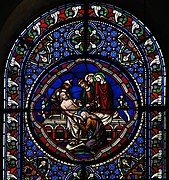 Chancel East Windows North Arch (Burial)
Chancel East Windows North Arch (Burial)
-
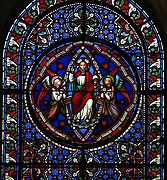 Chancel East Windows South Arch (Resurrection)
Chancel East Windows South Arch (Resurrection)
-
 Chancel East Windows South Arch (Ascension)
Chancel East Windows South Arch (Ascension)
-
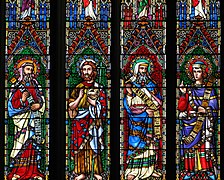 Nave west window (patriarchs and prophets)
Nave west window (patriarchs and prophets)
-
 Nave west window (Eve)
Nave west window (Eve)
-
 Nave west window (Banishment from Eden)
Nave west window (Banishment from Eden)
-
 Nave west window (Annunciation)
Nave west window (Annunciation)
-
 Nave west window (Baptism of Christ)
Nave west window (Baptism of Christ)
See also
110yds
 south gates9
Magazine8
south gates9
Magazine8The historic sites include:-
1 Leicester Castle
2 Castle gateway
3 Church of St Mary de Castro
4 Turret gateway
5 Trinity House - former Trinity Hospital
6 Newarke Houses Museum
7 site of Church of the Annunciation of Our Lady of the Newarke, now includes DMU heritage centre
8 Magazine Gateway
9 South gates
- Anglican churches in Leicester
- Grade I listed buildings in Leicester
- Leicester Castle
- Leicester Cathedral
- St Nicholas Church, Leicester
- St Margaret's Church, Leicester
References
- BBC. "A Haunted History: St Mary de Castro". Leicester. Retrieved 19 May 2013.
- ^ "Fears historic church spire may collapse". Leicester Mercury. 4 September 2013. Archived from the original on 21 September 2013. Retrieved 6 September 2013.
- Google may be Godsend for 900-year-old St Mary De Castro Church, in Leicester Archived 2014-02-02 at the Wayback Machine, Leicester Mercury, 28 August 2012. Accessed 26 January 2014
- Ellis, Colin (1948). History in Leicester. City of Leicester Publicity Department. pp. 21, 24.
- "History of St Mary de Castro".
- ^ W.G. Hoskins (editor) assisted by R.A. McKinley (1954). "Colleges: St Mary de Castro". A History of the County of Leicestershire: Volume 2. Institute of Historical Research. Retrieved 24 January 2014.
{{cite web}}:|author=has generic name (help) - ^ Pevsner, Nikolaus (1960). Leicestershire and Rutland. The Buildings of England. Harmondsworth: Penguin Books. pp. 144–148.
- William Arthur Shaw, The Knights of England, Vol.1, p.130 (London, 1906)
- Jenkins, Robin P. (2004). "Bickerstaffe, William". Oxford Dictionary of National Biography (online ed.). Oxford University Press. doi:10.1093/ref:odnb/2343. (Subscription or UK public library membership required.)
- "Leicester spire re-build needs £600,000". National Churches Trust. 12 March 2014. Retrieved 28 October 2020.
- "NPOR [N01304]". National Pipe Organ Register. British Institute of Organ Studies. Retrieved 23 February 2014.